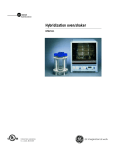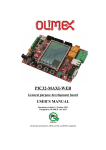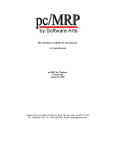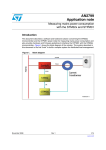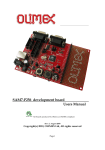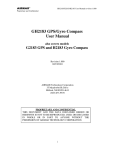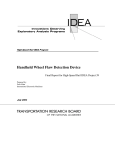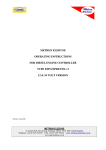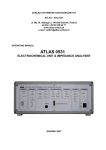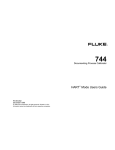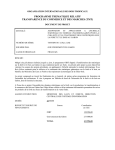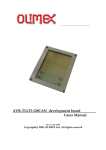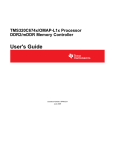Download STM32-LCD development board User`s manual
Transcript
STM32-LCD development board User's manual All boards produced by Olimex are ROHS compliant Revision C, May 2014 Copyright(c) 2014, OLIMEX Ltd, All rights reserved Page 1 INTRODUCTION: STM32-LCD is development prototype board with STM32F103ZE microcontroller from STMicroelectronics. This powerful microcontroller supports various serial interfaces such as USB, USART, SPI. In addition you will find also accelerometer, JTAG, TFT LCD, mini SD/MMC card connector on this board and most of the GPIOs are on extension headers where you can connect your additional circuits. All this allows you to build a diversity of powerful applications to be used in a wide range of situations. BOARD FEATURES: – Microcontroller – STM32F103ZE – high-performance ARM® Cortex™-M3 32-bit RISC core operating at a 72 MHz frequency, high-speed embedded memories (Flash memory – 512 Kbytes and SRAM – 64 Kbytes), and an extensive range of enhanced I/Os and peripherals connected to two APB buses. – JTAG connector – EXT connector – UEXT40 connector – UEXT1 connector – UEXT2 connector – EXT_PWR connector – Mini SD/MMC – Mini USB – LCD TFT 320x240 pixels colored with touch screen – Power source connector – Accelerometer – 8 MHz crystal oscillator – Reset circuit – Clock circuit – PCB: FR-4, 1.5 mm (0,062"), soldermask, silkscreen component print – Dimensions 79.2x57.6 mm (3.12x2.27)” Page 2 ELECTROSTATIC WARNING: The STM32-LCD board is shipped in protective anti-static packaging. The board must not be subject to high electrostatic potentials. General practice for working with static sensitive devices should be applied when working with this board. BOARD USE REQUIREMENTS: Cables: The required cables depend on the programmer/debugger that you use. Additionally, you might need USB mini cable for USB connection Hardware: You need a JTAG or SWD debugger or programmer to be able to program the board. The board has a standard 20-pin JTAG connector and typical layout (further detailed later in the document). You may check on our products ARM-JTAG-COOCOX, ARM-USB-OCD-H, ARMUSB-TINY-H. PROCESSOR FEATURES: – – – – STM32-LCD use High-density performance line ARM-based 32-bit MCU with these features: Core: ARM 32-bit Cortex™-M3 CPU – 72 MHz maximum frequency, 1.25 DMIPS/MHz (Dhrystone 2.1) performance at 0 wait state memory access – Single-cycle multiplication and hardware division Memories – 512 Kbytes of Flash memory – 64 Kbytes of SRAM – Flexible static memory controller with 4 Chip Select. Supports Compact Flash, SRAM, PSRAM, NOR and NAND memories – LCD parallel interface, 8080/6800 modes Clock, reset and supply management – 2.0 to 3.6 V application supply and I/Os – POR, PDR, and programmable voltage detector (PVD) – 4-to-16 MHz crystal oscillator – Internal 8 MHz factory-trimmed RC – Internal 40 kHz RC with calibration – 32 kHz oscillator for RTC with calibration Low power Page 3 – – Sleep, Stop and Standby modes – VBAT supply for RTC and backup registers 3 × 12-bit, 1 µs A/D converters (up to 21 channels) – Conversion range: 0 to 3.6 V – Triple-sample and hold capability – Temperature sensor – 2 × 12-bit D/A converters – DMA: 12-channel DMA controller – – – Debug mode – Serial wire debug (SWD) & JTAG interfaces – Cortex-M3 Embedded Trace Macrocell™ 112 fast I/O ports – – – – Supported peripherals: timers, ADCs, DAC, SDIO, I2Ss, SPIs, I2Cs and USARTs 112 I/Os, all mappable on 16 external interrupt vectors, all 5 V-tolerant except for analog inputs 11 timers – four 16-bit timers, each with up to 4 IC/OC/PWM or pulse counter and quadrature (incremental) encoder input – 2 × 16-bit motor control PWM timers with dead-time generation and emergency stop – 2 × watchdog timers (Independent and Window) – SysTick timer: a 24-bit downcounter – 2 × 16-bit basic timers to drive the DAC 13 communication interfaces – 2 × I2C interfaces (SMBus/PMBus) – 5 USARTs (ISO 7816 interface, LIN, IrDA capability, modem control) – 3 SPIs (18 Mbit/s), 2 with I2S interface multiplexed – CAN interface (2.0B Active) – USB 2.0 full speed interface – SDIO interface CRC calculation unit, 96-bit unique ID Page 4 BLOCK DIAGRAM: Page 5 MEMORY MAP: Page 6 SCHEMATIC: BAT_PWR VIN +5V_J-LINK D4 1N5819S D3 1N5819S +5V_USB D1 POWER SUPPLY CIRCUIT 1N5819S PWR D2 RF1 2 1N5819S 2 RF110_SMD R17 4V_MIN-6V_MAX 1 VIN #SHDN 330K/1% 3 C100 100nF 100uF/6.3V/tant 6 GND GND 10K Q3 BC807 3.3V 0R R38 C33 C10 C99 1uF 100nF MCP1825-ADJE/DC R51 R4 1 1.5K 330R 10 3.3V GND R18 USBDP 22R USBDM VDD_1 10 8 VDD_2 14 4 VDD_3 39 VDD_4 17 VDD_5 52 VDD_6 62 VDD_7 84 VDD_8 95 VDD_9 12 1 VDD_10 13 1 VDD_11 PA03/WKUP/US ART2_CTS/AD C123 _IN0 /TIM5 _CH1/TIM2_CH1 _ETR/TIM8_ETR 4 USB_P PA13/U /A DC1 23_IN1/TIM5_CH2/TIM2 _CH2 5 SART2_RTSPA1 R21 22R C16 72 0R 9 U9 0R 3.3V_MCU_E R24 4.7K 4.7K U5 ADJ5 47K/1% 3.3V R23 100nF 20K C96 3.3V C58 3.3V R10 R16 3.3V USB_P DISC 2K R14 10K C97 3.3V_E VOUT 4 ACCELEROMETER +5V_USB R9 R36 47K/1% VR1 1 USB CIRCUIT 3.3V R22 1 2 4 3 C32 C17 47pF(NA) 6 5 V BUS D- C2 C4 2 10uF/10V 10uF/10V 3 D+ SCK6 SDO 7 NC1 NC2 I2C2_SCL SDI/SDA 8 I2C2_SDA VD DIO VD D INT4 3.3V CSB5 GND SENS_INT SMB380,(QFN10) ID G ND (NA)USBLC6-2P6 100nF 47pF(NA) R41 1M PA23/U _CH3/ADC1 23_IN2/TIM2_CH3 6 SART2_TX/TIM5 USART2_TX PA33/U _CH4/ADC1 23_IN3/TIM2_CH4 7 SART2_RX/TIM5 USART2_RX C80 10nF PA44/S C_O UT1 /U SART2_CK/ADC12_IN4 0 PI1_NSS /DASPI1_NSS PA54/S C_OUT2 /A DC12 _IN5 1 PI1_SCK/DASPI1_SCK PA64/S /TIM1 _B KIN 2 PI1_MIS O/TIM8_BKIN/ADC12_IN6/TIM3_CH1 SPI1_MISO PA74/S N/A DC1 2_IN7 /TIM3 _CH2/TIM1_CH1 N 3 PI1_MOSI/TIM8_CH1 SPI1_MOSI PA81/U SART1_CK/TIM1 00 PA8 _CH1/MCO PA91/U SART1_TX/TIM1 _CH2 01 USART1_TX PA110/USA RT1 _RX /TIM 1_CH3 02 USART1_RX PA111/USA RT1 _CTS/CANRX/TIM1_CH4 /U SBDM 03 USBDM PA112/USA RT1 _RTS/CANTX/TIM1_ETR/USBD P 04 USBDP PA113/JTMS-SWDIO 05 TMS PA114/JTCK-SWCLK 09 TCK PA115/JTDI/S PI3_NSS 10 TDI/I2S 3_WS /TIM2_CH1_ETR/S PI1_NSS B1_0/B1_1 VBAT 71 VSS _1 10 7 VSS _2 14 3 VSS _3 38 VSS _4 16 VSS _5 51 VSS _6 61 VSS _7 83 VSS _8 94 VSS _9 12 0 VSS _10 13 0 VSS _11 3.3V B0_1/B0_0 1 3 3.3V_A 33 3.3V_A 0 C11 VREF+ 47R R20 C9 R40 10uF/6.3V 100nF 0R 100nF C47 32 NA C79 31 30 6 R15 C12 27pF 23 R12 Q1 8MHz U2 NA VCC NA R69 1 C28 100nF EXT 3.3V 1 2 3 4 PE1 PE6 PC7 PB5 5 6 7 8 9 10 +5V_USB 11 13 PG15 15 PG13 17 PG11 19 PG9 21 PG7 23 PG5 25 PG3 27 PG1 12 29 30 VBAT PD12 PB2 PA1 VIN PF0 PF1 PF2 PF3 PF4 PF5 PF6 PF7 PF8 PF9 PF10 PF11 PF12 PF13 PF14 PF15 14 PG14 PG12 PG10 PG8 PG6 PG4 PG2 PG0 16 18 20 22 24 26 28 31 32 33 34 35 36 37 38 39 RST PD6 PD11 USB_P PA8 40 25 PG0 PG1 PG2 PG3 PG4 PG5 PG6 PG7 PG8 PG9 PG10 PG11 PG12 PG13 PG14 PG15 RST 560R GND 3.3V PE0 PE5 PC6 PC13 VREFVSS A VBAT BH40R OSC_IN OSC_OUT 10 6 NC RST 10K RE SET 24 R19 390R C13 27pF R8 2 VREF+ 13 8 BOOT0 10K 3.3V VDDA 56 57 87 88 89 90 91 92 93 NRST PG0/FSMC_A10 PG1/FSMC_A11 PG2/FSMC_A12 PG3/FSMC_A13 PG4/FSMC_A14 PG5/FSMC_A15 PG6/FSMC_INT2 PG7/FSMC_INT3 PG8 12 4 PG9/FSMC_NE2 /FSMC_NCE 3 12 5 PG10 /FSMC_NCE4_1/FS MC_NE3 12 6 PG11 /FSMC_NCE4_2 12 7 PG12 /FSMC_NE 4 12 8 PG13 /FSMC_A2 4 12 9 PG14 /FSMC_A2 5 13 2 PG15 10 11 12 13 14 15 18 19 20 21 22 49 50 53 54 55 PF0 /FSMC_A0 PF1 /FSMC_A1 PF2 /FSMC_A2 PF3 /FSMC_A3 PF4 /FSMC_A4 PF5 /FSMC_A5 PF6 /A DC3_IN4/FS MC_NIO RD PF7 /A DC3_IN5/FS MC_NREG PF8 /A DC3_IN6/FS MC_NIO WR PF9 /A DC3_IN7/FS MC_CD PF1 0/ADC3 _IN8 /FSMC_INTR PF1 1/FSM C_NIOS 16 PF1 2/FSM C_A 6 PF1 3/FSM C_A 7 PF1 4/FSM C_A 8 PF1 5/FSM C_A 9 PB04/A _CH3/TIM8_CH2 N/TIM1_CH2N 6 DC1 2_IN8 /TIM3 ADC12_IN8 PB14/A _CH4/TIM8_CH3 N/TIM1_CH3N 7 DC1 2_IN9 /TIM3 ADC12_IN9 3 1 PB41/JNTRST/S PI3_MIS 34 TRSTO/TIM3_CH1 /S PI1_M IS O PB51/I2C1_SMBA I/SPI3 35 PB5 _MOS I/I2S 3_S D/TIM3_CH2/SPI1_MO SI PB81/TIM4_CH3/SDIO_D4/I2C1 39 I2C1_SCL2 _S CL/CANRX PB91/TIM4_CH4/SDIO_D5/I2C1 40 I2C1_SDA2 _S DA/CANTX PB160/I2 9 C2_SCL/USART3_TX I2C2_SCL /TIM2 _CH3 I2C1_SCL1 5 SPI1_MISO SPI1_SCK7 3.3V 3.3V_A DACOUT1 DACOUT2 9 2 I2C1_SDA1 SPI1_MOSI SPI1_NSS 6 8 10 +5V_USB11 13 PF15 15 PF13 17 PF11 19 PF9 21 PF7 23 PF5 25 PF3 27 PF1 12 29 30 31 32 VREF+ 33 35 SPI1_NSS 37 SPI1_SCK 34 39 USART1_RX 4 14 16 18 20 22 24 26 28 PF14 PF12 PF10 PF8 PF6 PF4 PF2 PF0 36 38 40 BH40R RST ADC12_IN8 ADC12_IN9 ADC12_IN14 ADC12_IN15 VIN R150 R155 10K 10K NA JTAG 10K R151 10K R153 R154 10K 10K 1 2 +5V_J-LINK R-T UEXT2_3.3V 3.3V 1 2 3 4 5 6 7 8 3.3V 0R 3.3V 100nF C19 9 10 R118 11 12 13 14 4.7K 15 16 17 18 19 20 UEXT2 USART2_TX I2C1_SCL2 SPI2_MISO SPI2_SCK BH20R PB175/SPI2 _MOS I/I2S2 _S D/TIM 1_CH3N 6 SPI2_MOSI 1 2 3 4 5 6 7 8 9 10 R119 R120 4.7K 33K USART2_RX I2C1_SDA2 SPI2_MOSI SPI2_NSS BH10R PC02/A 6 DC1 23_IN10 YD PC12/A 7 DC1 23_IN11 YU PC22/A 8 DC1 23_IN12 XL PC32/A 9 DC1 23_IN13 XR PC44/A 4 DC1 2_IN1 4ADC12_IN14 PC54/A 5 DC1 2_IN1 5ADC12_IN15 PC69/I2S 6 2_MCK/TIM8 PC6_CH1/SDIO_D 6/TIM3_CH1 UEXT1 PC79/I2S 7 3_MCK/TIM8 PC7_CH2/SDIO_D 7/TIM3_CH2 PC89/TIM8_CH3/SDIO_D0/TIM3 _CH3 SD_D0 8 SD/MMC CARD PC99/TIM8_CH4/SDIO_D1/TIM3 _CH4 SD_D1 9 PC110/UART4_TX/SD IO _D2 /US ART3_TX SD_D2 11 PC111/UART4_RX/SD IO_D3/US ART3_RX SD_D3 12 PC112/UART5_TX/SD IO _CK/U SART3_CK SD_CLK 13 PC173/TAM PER-RTC PC13 PC184/OSC32_IN NA PC195/OSC32_OUT R104 UEXT1_3.3V 3.3V C15 Q2 32768/6pF C14 GND 3.3V R6 UEXT1 4.7K 10pF R108 33K R107 33K USART1_TX I2C1_SCL1 SPI1_MISO SPI1_SCK USD PD31/FSMC_CLK/USA RT2 _CTS 17 DISC PD41/FSMC_NOE /U SART2_RTS 18 /OE 10 12 PD51/FSMC_NWE /US ART2_TX 19 /WE PD61/FSMC_NWAIT/US 22 PD6 ART2_RX PD71/FSMC_NE 1/FSMC_NCE2/US ART2_CK 23 /NCE2 SD_D3 SD_CMD PD87/FSMC_D13 /UD13 SART3_TX 7 PD97/FSMC_D14 /UD14 SART3_RX 8 SD_D3 SD_CMD 2 3 6 3.3V PD170/FSM C_D1 5/USA 9 D15 RT3 _CK PD181/FSM C_A 16/USA 0 PD11RT3 _CTS SD_CLK SD_D0 SD_D1 SD_D2 PD182/FSM C_A 17/TIM4_CH1 /U SART3_RTS 1 PD12 PD183/FSM C_A 18/TIM4_CH2 2 TFT_LIGHT 3.3V 3.3V 3.3V PD184/FSM C_D0 /TIM4_CH3 D0 5 PD185/FSM C_D1 /TIM4_CH4 D1 6 PE01/TIM4_E TR/FSMC_NBL0 41 PE0 PE11/FSMC_NB L1 PE1 42 L5 470nH 4 SD_CLK SD_D0 SD_D1 SD_D2 5 7 8 1 R106 33K R100 33K R105 33K 9 11 C20 PE21/TRACECK/FSMC_A2 3 TFT_RST PE32/TRACED0 /FSMC_A19 TFT_RS 47uF/6.3V PE43/TRACED1 /FSMC_A20 SENS_INT PE54/TRACED2 /FSMC_A21 PE5 PE65/TRACED3 /FSMC_A22 PE6 PE75/FSMC_D4 /TIM1 D4_E TR 8 PE85/FSMC_D5 /TIM1 D5_CH1N 9 WP1 PE161/FS 4 MC_D 8/TIM1_CH2 D8 PE162/FS 5 MC_D 9/TIM1_CH3N D9 PE163/FS 6 MC_D 10/TIM1_CH3 D10 PE164/FS 7 MC_D 11/TIM1_CH4 D11 PE165/FS 8 MC_D 12/TIM1_BKIN D12 1 2 3 4 5 6 7 8 9 10 WP2 CON6 1 +5V_USB 2 3 4 5 6 EXT_PWR BAT_PWR R13 4.7K 33K BH10R CMD/DI V SS V DD CLK/SCLK 3.3V 3.3V 3.3V D AT0 /DO D AT1 /RES D AT2 /RES R2 R7 R3 NA NA NA 3.3V CP1 CP2 MICRO_SD_CARD_holder TFT_RST /NCE2 TFT_RS /WE /OE TFT #RESE T 8 #CS 4 5 RS 6 #WR 7 #RD 9 DB 0 1 0 DB 1 1 1 DB 2 1 2 DB 3 1 3 DB 4 1 4 DB 5 1 5 DB 6 1 6 DB 7 1 7 DB 8 1 8 DB 9 1 9 DB 10 2 0 DB 11 2 1 DB 12 2 2 DB 13 2 3 DB 14 2 4 DB 15 2 VCC 3 VCC C1 C3 100nF 100nF 1 GND 25 GND YD XL YU XR 26 27 28 29 35 LE DA 36 LE DA YD XL YU XR 3.3V R_LCD 30 LE DK1 31 LE DK2 32 LE DK3 33 LE DK4 34 LE DK5 37 GND FS-K320QVB-V1 OLIMEX LTD, BULGARIA 2014 R11 USART1_RX I2C1_SDA1 SPI1_MOSI SPI1_NSS CD/DAT3 /CS D0 D1 D2 D3 D4 D5 D6 D7 D8 D9 D10 D11 D12 D13 D14 D15 PE96/FSMC_D6 /TIM1 D6_CH1 0 PE160/FS 3 MC_D 7/TIM1_CH2N D7 3.3V 100nF C18 10pF PD01/O NRX D2 14SC_IN/FSMC_D2/CA PD11/O D3 15SC_OUT/FSMC_D3/CANTX PD21/TIM RT5 _RX /S DIO _CM D 16 3_E TR/UA SD_CMD 3.3V 0R 3.3V STM32-LCD, board revision A https://www.olimex.com R147 10K R149 TRST PB173/SPI2 _SCK/I2 S2_CK/US ART3_CTS/TIM1 _CH1N 4 SPI2_SCK PB174/SPI2 _MISO/US ART3_RTS/TIM1 _CH2N 5 SPI2_MISO UEXT40 3 R148 10K TDO RST PB171/I2 SART3_RX/TIM2_CH4 0 C2_SDA /U I2C2_SDA PB172/SPI2 _NS S/I2 S2_WS/I2 C2_SMB AI/U SART3_CK/TIM1_BKIN 3 SPI2_NSS 3.3V 1 USART1_TX R152 TRST TDI TMS TCK PB61/I2C1_SCL/TIM4 _CH1/USA RT1 _TX 36 I2C1_SCL1 PB71/I2C1_SDA/FS MC_NL/TIM4 _CH2/USART1_RX 37 I2C1_SDA1 UEXT2 3.3V 3.3V R54 PB24/B PB2 8 OOT1 10K PB31/TRACESWO /JTDO 33 TDO /S PI3_SCK/I2S 3_CK/TIM2_CH2 /S PI1_S CK 0R FET1 IRLML6402 R1 100K R50 1.5K TFT_LIGHT BOARD LAYOUT POWER SUPPLY CIRCUIT: STM32-LCD can take power from four sources: – Power connector – 4V – 6V DC. – BAT_PWR from EXT_PWR – 4V DC. – +5V_J-LINK from JTAG connector – +5V_USB from USB connector The programmed board power consumption is about 200 mA. RESET CIRCUIT: STM32-LCD reset circuit includes R8 (10k), R69 (560 Ohm), C28 (100nF) pin 15 of JTAG connector, EXT pin 32, UEXT40 pin 32 and STM32F103ZE pin 25 (NRST). CLOCK CIRCUIT: Quartz crystal 8 MHz is connected to STM32F103ZE pin 23 (OSC_IN) and pin 24 (OSC_OUT). Quartz crystal 32.768 kHz is connected to STM32F103ZE pin 8 (PC14/OSC32_IN) and pin 9 (PC15/OSC32_OUT). Page 8 JUMPER DESCRIPTION: R-T Connect RST with TRST. Default state is open. UEXT1_3.3V This jumper when closed, supplies 3.3 V voltage to UEXT1 pin 1. Default state is closed. UEXT2_3.3V This jumper when closed, supplies 3.3 V voltage to UEXT2 pin 1. Default state is closed. 3.3V_E This jumper, when closed, enable the main 3.3 V regulator VR1 - MCP1825-ADJE/DC. Default state is closed. 3.3V_MCU_E This jumper, when closed, enables STM32F103ZE 3.3 V power supply. Default state is closed. R_LCD You can use this jumper, when it's open, to measure the current of LCD backlight. Default state is closed. B0_1/B0_0 Select BOOT0 Boot mode. Default state is in position B0_0. B1_0/B1_1 Select BOOT1 Boot mode. Default state – B1_0 – not shorted and B1_1 – not shorted. Boot mode selection pins Boot Mode Aliasing BOOT1 BOOT0 x 0 Main Flash memory Main Flash memory is selected as boot space 0 1 System memory System memory is selected as boot space 1 1 Embedded SRAM Embedded SRAM is selected as boot space INPUT/OUTPUT: – LCD TFT 320x240 pixels colored with touch screen. Page 9 EXTERNAL CONNECTORS DESCRIPTION: UEXT1 Pin # Signal Name 1 3.3V 2 GND 3 USART1_TX 4 USART1_RX 5 I2C1_SCL1 6 I2C1_SDA1 7 SPI1_MISO 8 SPI1_MOSI 9 SPI1_SCK 10 SPI1_NSS UEXT2 Pin # Signal Name 1 3.3V 2 GND 3 USART2_TX 4 USART2_RX 5 I2C1_SCL2 6 I2C1_SDA2 7 SPI2_MISO 8 SPI2_MOSI 9 SPI2_SCK 10 SPI2_NSS Page 10 EXT Pin # Signal Name Pin # Signal Name 1 3.3 V 2 GND 3 PE0 4 PE1 5 PE5 6 PE6 7 PC6 8 PC7 9 PC13 10 PB5 11 3.3 V 12 GND 13 +5V_USB 14 VIN 15 PG15 16 PG14 17 PG13 18 PG12 19 PG11 20 PG10 21 PG9 22 PG8 23 PG7 24 PG6 25 PG5 26 PG4 27 PG3 28 PG2 29 PG1 30 PG0 31 VBAT 32 RST 33 GND 34 PD6 35 PD12 36 PD11 37 PB2 38 USB_P 39 PA1 40 PA8 Page 11 UEXT40 Pin # Signal Name Pin # Signal Name 1 3.3 V 2 GND 3 USART1_TX 4 USART1_RX 5 I2C1_SCL1 6 I2C1_SDA1 7 SPI1_MISO 8 SPI1_MOSI 9 SPI1_SCK 10 SPI1_NSS 11 3.3 V 12 GND 13 +5V_USB 14 VIN 15 PF15 16 PF14 17 PF13 18 PF12 19 PF11 20 PF10 21 PF9 22 PF8 23 PF7 24 PF6 25 PF5 26 PF4 27 PF3 28 PF2 29 PF1 30 PF0 31 3.3V_A 32 RST 33 AGND 34 ADC12_IN8 35 VREF+ 36 ADC12_IN9 37 SPI1_NSS 38 ADC12_IN14 39 SPI1_SCK 40 ADC12_IN15 Page 12 JTAG: The JTAG connector allows a debugger or programmer to talk via a JTAG (Joint Test Action Group) port directly to the core. Instructions may be inserted and executed by the core thus allowing STM32F103ZE memory to be programmed with code and executed step by step by the host software. Pin # Signal Name Pin # Signal Name 1 3.3V 2 3.3V 3 TRST 4 GND 5 TDI 6 GND 7 TMS 8 GND 9 TCK 10 GND 11 pull-down 12 GND 13 TDO 14 GND 15 RST 16 GND 17 pull-down 18 GND 19 +5V J-LINK 20 GND Page 13 USB Pin # Signal Name 1 +5V_USB 2 USBDM 3 USBDP 4 NC 5 GND PWR Pin # Signal Name 1 VIN (4 – 6) V DC 2 GND SD/MMC Pin # Signal Name 1 SD_D2 2 SD_D3 3 SD_CMD 4 VDD (3.3V) 5 SD_CLK 6 GND 7 SD_D0 8 SD_D1 9 Not connected 10 Not connected 11 Not connected 12 Not connected Page 14 SPI Up to three SPIs are able to communicate up to 18 Mbits/s in slave and master modes in full-duplex and simplex communication modes. The 3-bit prescaler gives 8 master mode frequencies and the frame is configurable to 8 bits or 16 bits. The hardware CRC generation/verification supports basic SD Card/MMC modes. All SPIs can be served by the DMA controller. I2S Two standard I2S interfaces (multiplexed with SPI2 and SPI3) are available, that can be operated in master or slave mode. These interfaces can be configured to operate with 16/32 bit resolution, as input or output channels. Audio sampling frequencies from 8 kHz up to 48 kHz are supported. When either or both of the I2S interfaces is/are configured in master mode, the master clock can be output to the external DAC/CODEC at 256 times the sampling frequency. I2C Up to two I²C bus interfaces can operate in multimaster and slave modes. They can support standard and fast modes. They support 7/10-bit addressing mode and 7-bit dual addressing mode (as slave). A hardware CRC generation/verification is embedded. They can be served by DMA and they support SMBus 2.0/PMBus. Page 15 MECHANICAL DIMENSIONS Page 16 AVAILABLE DEMO SOFTWARE – EW-ARM general demo code – the code of the initial STM32-LCD demo – EW-ARM Demo code for MOD-GSM and MOD-GSM-EDGE - (high speed) GSM modules connected to STM32-LCD Page 17 ORDER CODE: STM32-LCD – assembled and tested board How to order? You can order directly from us or from any of our distributors. Please check our web-site https://www.olimex.com for more info. Revision history: Manual revision: Rev. Initial, May 2009 Rev. A, June 2011 – changed schematic Rev. B, October 2011 – added more detailed mechanical dimensions Rev. C, May 2014 – updated board schematic, added board revision history, updated disclaimer, updated links Board revision: Rev. Initial, May 2009 Rev. A, May 2014 1. The analog GND got properly connected to the digital GND through a 0 Ohm resistor 2. Fixed the JTAG label (was “JATG” before) 3. The LCD GND got properly connected 4. The cathodes of the LCD 's backlight got connected to GND 5. C1 i C3 are moved further away from the LCD connector 6. The accelerometer is changed from LISxx to SMB380 7. Added RC filter to the power suppl of SMB380 Page 18 Disclaimer: © 2014 Olimex Ltd. Olimex®, logo and combinations thereof, are registered trademarks of Olimex Ltd. Other product names may be trademarks of others and the rights belong to their respective owners. The information in this document is provided in connection with Olimex products. No license, express or implied or otherwise, to any intellectual property right is granted by this document or in connection with the sale of Olimex products. It is possible that the pictures in this manual differ from the latest revision of the board. The product described in this document is subject to continuous development and improvements. All particulars of the product and its use contained in this document are given by OLIMEX in good faith. However all warranties implied or expressed including but not limited to implied warranties of merchantability or fitness for purpose are excluded. This document is intended only to assist the reader in the use of the product. OLIMEX Ltd. shall not be liable for any loss or damage arising from the use of any information in this document or any error or omission in such information or any incorrect use of the product. This evaluation board/kit is intended for use for engineering development, demonstration, or evaluation purposes only and is not considered by OLIMEX to be a finished end-product fit for general consumer use. Persons handling the product must have electronics training and observe good engineering practice standards. As such, the goods being provided are not intended to be complete in terms of required design-, marketing-, and/or manufacturing-related protective considerations, including product safety and environmental measures typically found in end products that incorporate such semiconductor components or circuit boards. Olimex currently deals with a variety of customers for products, and therefore our arrangement with the user is not exclusive. Olimex assumes no liability for applications assistance, customer product design, software performance, or infringement of patents or services described herein. THERE IS NO WARRANTY FOR THE DESIGN MATERIALS AND THE COMPONENTS USED TO CREATE STM32-LCD. THEY ARE CONSIDERED SUITABLE ONLY FOR STM32-LCD. Page 19



















